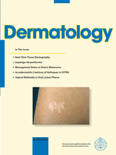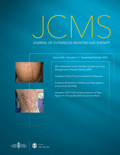
AUSTRALASIAN JOURNAL OF DERMATOLOGY
Scope & Guideline
Fostering scholarly dialogue in skin health.
Introduction
Aims and Scopes
- Clinical Dermatology and Therapeutics:
The journal focuses on clinical studies and trials that evaluate the efficacy and safety of dermatological treatments, including the use of biologics, systemic therapies, and topical agents for various skin conditions. - Public Health and Epidemiology:
Research addressing the epidemiology of skin diseases, including prevalence, risk factors, and the impact of skin conditions on public health, particularly in diverse populations within Australasia. - Dermatopathology and Diagnostics:
Investigations into the histological and molecular aspects of skin diseases, enhancing diagnostic accuracy and understanding of disease mechanisms. - Innovative Technologies and Treatments:
The AJD publishes studies exploring new technologies in dermatology such as artificial intelligence for diagnosis, teledermatology, and novel therapeutic approaches to skin conditions. - Patient-Centered Care and Quality of Life:
The journal emphasizes research that evaluates the psychosocial impact of skin diseases and treatment adherence, aiming to improve patient outcomes and quality of life. - Cultural and Indigenous Health Perspectives:
Research that considers the unique dermatological needs and experiences of Indigenous populations and culturally diverse communities in Australasia.
Trending and Emerging
- Biologics and Targeted Therapies:
An increasing number of studies focus on the efficacy and safety of biologic agents and targeted therapies for chronic skin diseases, reflecting advancements in treatment options for conditions like psoriasis and atopic dermatitis. - Teledermatology and Digital Health:
Research on teledermatology and digital health solutions has expanded, particularly in the context of improving access to care during the COVID-19 pandemic, demonstrating the potential for remote consultations and monitoring. - Mental Health and Dermatology:
There is a growing trend towards exploring the relationship between skin conditions and mental health, emphasizing the psychosocial impact of dermatological diseases and the importance of holistic patient care. - Diversity in Dermatology:
Emerging research is increasingly addressing the representation and unique dermatological needs of diverse populations, including Indigenous communities, thereby promoting health equity in dermatological care. - Artificial Intelligence in Dermatology:
The application of artificial intelligence in diagnosing skin conditions and improving clinical outcomes is gaining traction, with studies exploring its potential to enhance diagnostic accuracy and treatment efficacy.
Declining or Waning
- Traditional Dermatological Practices:
There has been a noticeable decrease in publications focusing on traditional dermatological practices and treatments, as the field moves towards evidence-based and innovative therapies. - General Dermatology Reviews:
The frequency of broad review articles covering general dermatology topics has declined, with a shift towards more specialized and focused research. - Invasive Surgical Techniques:
Research related to invasive surgical techniques, such as excisional surgeries and traditional skin grafting, has seen a decrease as minimally invasive and non-invasive techniques gain preference. - Aging Population Studies:
While still relevant, there has been a waning focus on dermatological issues specifically related to aging populations, possibly overshadowed by more immediate concerns such as chronic inflammatory conditions. - Cosmetic Dermatology:
Publications in the realm of cosmetic dermatology have become less frequent, indicating a potential shift in research priorities towards medical dermatology and treatment of chronic conditions.
Similar Journals

ANAIS BRASILEIROS DE DERMATOLOGIA
Exploring Innovations in Skin Health and Research.ANAIS BRASILEIROS DE DERMATOLOGIA is a prestigious academic journal published by Elsevier Science Inc, specializing in the dynamic field of dermatology. With its Open Access model established in 2002, this journal ensures wide dissemination of research findings and facilitates collaboration within the dermatological community. Hailing from Brazil, it provides a platform for innovative research from both local and international contributors, spanning from its inception in 1963 to the current year, 2024. The journal positions itself as a vital resource in the dermatology sphere, currently ranked in the Q3 category for dermatology and holding a notable rank of 71 out of 142 in the Scopus rankings, placing it in the 50th percentile for its field. With a commitment to advancing knowledge and practice in dermatology, ANAIS BRASILEIROS DE DERMATOLOGIA is an essential read for researchers, professionals, and students eager to explore contemporary advancements and clinical practices.

DERMATOLOGY
Pioneering research, transforming skin health.DERMATOLOGY, an esteemed journal published by KARGER, is a vital resource in the field of dermatological research and clinical practice. Established in 1893, with its comprehensive coverage extending to 2024, this journal has earned its place as a leading publication, holding a prestigious Q1 quartile ranking in Dermatology and ranking 15th out of 142 in the Scopus Medicine - Dermatology category, reflecting its 89th percentile standing within the discipline. The journal aims to disseminate innovative research findings, critical reviews, and clinical studies that advance the understanding of skin disorders and their treatments. While primarily available through institutional subscriptions, DERMATOLOGY remains committed to enhancing accessibility and fostering international collaboration among researchers, professionals, and students in the dermatological community. Its rigorous peer-review process guarantees the highest quality of published works, making it an essential reference for those dedicated to advancing dermatological science and improving patient care.

Dermatology Research and Practice
Unlocking insights in dermatology for better patient care.Dermatology Research and Practice is a premier open access journal published by HINDAWI LTD, dedicated to advancing the field of dermatology since its establishment in 2009. With a respectable impact factor and a ranking of #42 out of 142 in the Scopus Medicine - Dermatology category, the journal stands in the 70th percentile, reflecting its influence and relevance in contemporary dermatological research. Based in Egypt, it provides a platform for groundbreaking studies that shape clinical practice and policy worldwide. The journal covers a wide range of topics within dermatology, including but not limited to clinical research, epidemiology, and patient care, making it an essential resource for researchers, healthcare professionals, and students seeking to enhance their understanding and contribute to the field. Emphasizing open access, Dermatology Research and Practice ensures that vital research findings are readily available to the global community, fostering collaboration and innovation in dermatology.

JOURNAL OF DERMATOLOGY
Illuminating the path to dermatological excellence.The Journal of Dermatology, published by Wiley, is a premier academic journal dedicated to advancing the field of dermatology, with its esteemed reputation reflected in its Q1 ranking in Dermatology and a remarkable Q2 ranking in Miscellaneous Medicine as of 2023. Since its inception in 1974, the journal has become a vital resource for researchers, clinicians, and students alike, covering pioneering studies and cutting-edge advancements in skin health and disease. With a Scopus rank of #32 out of 142 in the Dermatology category, placing it in the 77th percentile, the journal underscores its commitment to fostering knowledge and innovation within the dermatological community. Although the journal operates under a subscription model, it remains an essential platform for disseminating impactful research that shapes clinical practice and enhances patient care. For anyone invested in dermatological sciences, Journal of Dermatology serves as a key publication where critical insights and developments are regularly showcased.

INTERNATIONAL JOURNAL OF DERMATOLOGY
Elevating skin health through rigorous research.The INTERNATIONAL JOURNAL OF DERMATOLOGY, published by WILEY, stands as a premier scholarly platform in the field of dermatology, with a notable impact factor that affirms its quality and renown. Established in 1963 and converging through to 2024, this journal is recognized as a Q1 category publication, ranking in the top 20% of journals within the dermatology field according to the Scopus ranking system, where it occupies the 28th position among 142 journals. This reflects its dedication to advancing the understanding and treatment of skin diseases, making it a vital resource for researchers, healthcare professionals, and medical students alike. Although it does not provide open access options, articles published in this journal cover a broad range of dermatological topics, ensuring that it serves as a comprehensive and authoritative source for cutting-edge research and clinical practices. With its rigorous peer-review process and commitment to high standards, the INTERNATIONAL JOURNAL OF DERMATOLOGY remains indispensable for those engaged in dermatological science and practice.

Postepy Dermatologii i Alergologii
Bridging gaps in knowledge for skin and allergy specialists.Postepy Dermatologii i Alergologii is a distinguished Open Access journal published by TERMEDIA PUBLISHING HOUSE LTD, dedicated to advancing the fields of Dermatology and Immunology and Allergy. Since its inception in 2003, this journal has served as a vital platform for researchers and practitioners alike, promoting knowledge sharing and collaboration in Poland and beyond. With a current impact ranking placing it in the Q3 quartile for both Dermatology and Immunology and Allergy categories, it plays a significant role in contributing to academic discourse within these fields. The journal is indexed in Scopus, with respectable rankings reflecting its relevance and quality—#65/142 in Dermatology and #163/233 in Immunology and Allergy. Researchers are encouraged to explore a vast array of innovative studies and reviews, making it an essential resource for anyone seeking to stay at the forefront of dermatological and allergic research. For those interested in discovering groundbreaking findings and contributing to the ongoing dialogue in these disciplines, Postepy Dermatologii i Alergologii offers not only free accessibility but also a commitment to scholarly excellence.

JOURNAL OF DERMATOLOGICAL TREATMENT
Exploring the forefront of skin health research.The JOURNAL OF DERMATOLOGICAL TREATMENT, published by TAYLOR & FRANCIS LTD, is a premier forum dedicated to advancing the field of dermatology through the dissemination of high-quality research. Since its inception in 1989, this journal has maintained a significant impact on the dermatological community, currently ranking in the top quartile (Q1) of the Dermatology category with an impressive Scopus ranking of #14 out of 142 journals, reflecting its reputation among peers and its contribution to the clinical and academic landscape. The journal shifted to Open Access in 2023, enhancing the accessibility of groundbreaking findings to researchers, clinicians, and students worldwide. With a commitment to publishing diverse articles, from innovative treatment modalities to comprehensive reviews, the JOURNAL OF DERMATOLOGICAL TREATMENT serves as an invaluable resource for professionals seeking to stay at the forefront of dermatological science in a rapidly evolving field.

Dermatologie
Advancing the Science of Skin HealthDermatologie, published by SPRINGER HEIDELBERG, is a prominent journal dedicated to the advancing field of dermatology. With its ISSN 2731-7005 and E-ISSN 2731-7013, this journal has established itself as a valuable resource for researchers, professionals, and students alike. Originating in Germany, the journal focuses on disseminating innovative research from 2022 to 2024, contributing significantly to the understanding of skin health and disease management. Despite its current ranking within the Q3 category in dermatology and a Scopus rank of #88/142, it provides critical insights and advances in clinical practice, epidemiology, and therapeutic modalities. With an emphasis on open discourse, it seeks to foster collaboration among healthcare professionals and researchers, thereby enhancing the quality and accessibility of dermatological research. Engage with Dermatologie to stay at the forefront of the latest advancements in skin-related health issues.

JOURNAL OF CUTANEOUS MEDICINE AND SURGERY
Transforming insights into practice for skin-related health.The Journal of Cutaneous Medicine and Surgery is a premier publication in the fields of dermatology and surgery, dedicated to advancing the scientific understanding of skin-related conditions and surgical techniques. Published by SAGE Publications Inc, this esteemed journal features a rich repository of peer-reviewed research, reviews, and clinical studies, ensuring that it remains at the forefront of dermatologic and surgical innovation. With an impressive impact factor and a ranking in the top quartile (Q1) of both dermatology and surgery categories for 2023, it is recognized as a vital resource for professionals, researchers, and students alike. The journal has consistently made significant contributions to the knowledge base that guides clinical practice and surgical decision-making, fostering a deeper understanding of the complexities involved in cutaneous medicine. For comprehensive updates, researchers can access this journal through SAGE’s platform, which supports the dissemination of high-quality research findings to a global audience.

Hong Kong Journal of Dermatology & Venereology
Exploring the Frontiers of Dermatological ScienceThe Hong Kong Journal of Dermatology & Venereology is a vital publication in the field of dermatology, dedicated to advancing research and clinical practice in this specialized area. Published by MEDCOM LTD, this journal has been a resourceful platform for dermatologists, researchers, and students since its inception in 2005, showcasing rigorous original research, comprehensive reviews, and case studies pertinent to both dermatology and venereology. Although currently categorized in Q4 of the dermatology quartiles, it serves as an important voice for the region, contributing to the global dialogue on skin and sexually transmitted diseases. With an ISSN of 1814-7453, the journal aims to bridge gaps in understanding and foster innovations that will lead to better patient care and outcomes. Readers can access its content, while researchers are encouraged to contribute to this growing body of knowledge that plays a critical role in enhancing dermatological practice in Hong Kong and beyond.